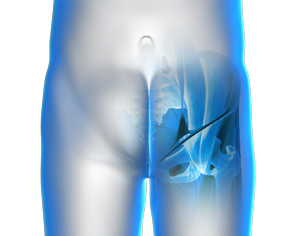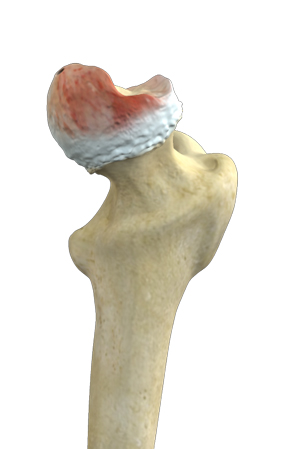-
Hip Ligament Injuries
Hip Adductor Injuries
Hip adductors are the group of muscles on the inner side of your thigh that enable adduction or the ability to bring the thighs together.
Know More -
Hip Injury

This is an injury to the labrum, the cartilage that surrounds the outside rim of your hip joint socket. A tear in the labrum of the hip can result from traumatic injury, such as a motor vehicle accident or from participating in sports such as football, soccer, basketball, and skiing.
Know More -
Gluteus Tendon Tear

The gluteal muscles (situated in the buttocks) are necessary for the stability and movement of the hip joints. The tendons of two gluteal muscles (gluteus medius and gluteal minimus) are attached at the outer hip region and are often called the “rotator cuff of the hip.”
Know More -
Partial Hamstring Tears

The hamstring is a group of three muscles known as semimembranosus, semitendinosus, and biceps femoris that run along the back of the thigh from the hip to the knee and help you extend your hip and bend your knee.
Know More -
Hip Abductor Tears

Hip abductors are a major group of muscles found in the buttocks. It includes the gluteus maximus, gluteus medius, gluteus minimus, and tensor fascia lata muscles.
Know More -
Hip Fracture
Stress Fractures of the Hip
Stress fractures of the hip are a break in the upper part of the thigh bone (femur) that fits into the socket of the hip joint. It can occur in any part of the hip, however, it mostly occurs just below the ball of the ball-and-socket hip joint called the femoral neck.
Know More -
Avulsion Fractures of the Pelvis

Avulsion fractures of the pelvis is an injury that occurs when a tendon or ligament pulls off a piece of bone from the hip. This results in a part of the pelvic (hip) bone breaking away from the main part of the bone.
Know More -
Periprosthetic Hip Fractures

Some cases of periprosthetic hip fracture are caused by a loose implant. Joint-revision involves the removal of the old implant and placement of a new implant with special components to treat the fracture.
Know More -
Femoral Neck Fracture

Fractures to the femoral neck can completely or partially disconnect the femoral head from the rest of the femur. Femoral neck fractures may be either displaced, where the bone is moved out of its original position, or non-displaced, where there is no instability of the bone.
Know More -
Femur Fracture

A femur fracture is a break in the femur. The distal femur is the lower part of the thigh bone which flares out like an upside-down funnel and its lower end is covered by a smooth, slippery articular cartilage that protects and cushions the bone during movement.
Know More -
Intertrochanteric Fractures

Intertrochanteric fractures account for about thirty-eight to fifty percent of all hip fractures and are very commonly seen in the elderly. Women are more prone to these fractures than men.
Know More -
Femoral Shaft Fracture

A femoral shaft fracture is a crack or break anywhere along the long and straight section of the femur (thighbone) due to high-energy trauma or low-energy trauma in osteoporotic patients. The femur is the strongest and longest bone in the body.
Know More -
Femoroacetabular Impingement

Femoroacetabular impingement (FAI) is a condition characterized by excessive friction in the hip joint from the presence of bony irregularities. These cause pain and decreased range of hip motion.
Know More -
Hip Pain

Hip pain, one of the common complaints, may not always be felt precisely over the hip joint rather in and around the hip joint. The cause for pain is multifactorial and the exact position of your hip pain suggests the probable cause or underlying condition causing it.
Know More -
Gluteal Strain

A gluteal strain is a condition characterized by a partial or complete tear of the gluteus muscles, also known as the buttocks. The gluteus muscles are a group of strong muscles present at the back of the pelvis. These muscles help with the movement and stabilization of the hip joint.
Know More -
Iliopsoas Tendonitis

Iliopsoas tendonitis also referred to as snapping hip syndrome, is an inflammation of the iliopsoas tendon or the surrounding area. The iliopsoas is the hip flexor tendon located over the front of the hip socket. The term snapping hip describes the sound made, a snap or click, that occurs with certain hip movements including flexion, extension, and rotation of the hip.
Know More -
Iliopsoas Impingement

Iliopsoas impingement also known as internal snapping hip syndrome is a condition characterized by inflammation and pain in the iliopsoas muscles resulting in abnormal movement of the hip.
Know More -
Hip Bursitis

Hip bursitis is a painful condition caused by the inflammation of a bursa in the hip. Bursae are fluid-filled sacs present in the joints between bone and soft tissue to reduce friction and provide cushioning during movement.
Know More -
Avascular Necrosis

Avascular necrosis, also called osteonecrosis, is a condition in which bone death occurs because of inadequate blood supply to it. Lack of blood flow may occur when there is a fracture in the bone or a joint dislocation that may damage nearby blood vessels.
Know More -
Hip Dislocation

Hip dislocation can be caused by injuries from motor vehicle accidents or severe falls.
Know More -
Hip Instability

Hip instability can be traumatic or atraumatic. Traumatic instability can be caused by injuries from sports or motor vehicle accidents. These injuries can damage the bony structures, labrum, and cartilage of the hip joint and form loose bodies.
Know More -
Hip Synovitis

Hip synovitis, also called transient hip synovitis or toxic synovitis, is a condition characterized by inflammation of the synovial tissues that surround the hip joint. It is the most common cause for sudden hip pain that occurs in young children between the age of 2 and 9.
Know More -
Developmental Dysplasia

Developmental dysplasia of the hip (DDH) or hip dysplasia is a condition that is seen in infants and young children because of developmental problems in the hip joint.
Know More -
Hip Tendonitis

Hip tendonitis can be treated with the help of RICE: rest, ice, compression, and elevation. You may also be referred to a physical therapist who will instruct you on stretching exercises to regain motility.
Know More -
Hip Osteonecrosis

Hip osteonecrosis occurs due to disruption of the blood supply to the highest part of the thigh bone (femoral head). Due to lack of nourishment, the bone tissue of the femoral head dies and gradually collapses, which may further lead to degeneration of the underlying cartilage.
Know More




































